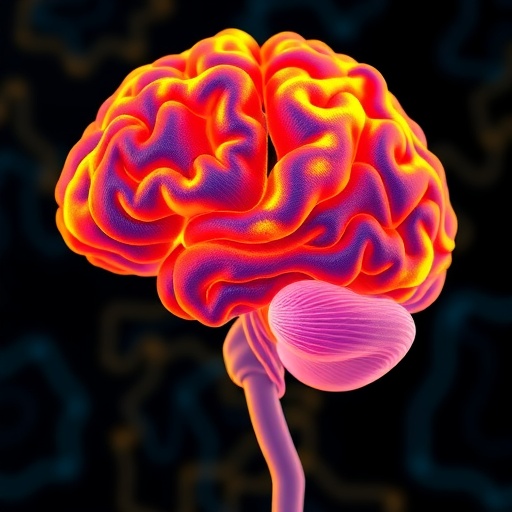In the ongoing quest to unravel the molecular intricacies of Alzheimer’s dementia, a groundbreaking study has emerged from an international consortium of neuroscientists and molecular biologists, employing an integrative brain omics approach that has illuminated the enigmatic role of lipid metabolism in disease pathology. The research, recently published in Nature Communications, highlights the significance of a specific lipid molecule—sn-1 lysophosphatidylethanolamine (LPE)—as a critical player in Alzheimer’s dementia, offering a fresh avenue for therapeutic exploration and biomarker development.
This study leverages cutting-edge omics technologies, encompassing genomics, transcriptomics, proteomics, and lipidomics, to create a holistic molecular portrait of the Alzheimer’s brain, with unprecedented resolution. Unlike prior investigations that largely focused on hallmark proteins such as amyloid-beta and tau, this integrative approach recognizes the complexity of biochemical networks perturbed in the disease and shifts attention to the lipidome, a previously underappreciated component in neurodegeneration. By synthesizing multi-dimensional data sets, the researchers identify significant dysregulation of sn-1 LPE species, correlating tightly with cognitive decline and neuropathological severity.
The lipidomics analysis reveals that sn-1 LPE species are distinctly altered in cortical and hippocampal regions severely affected by Alzheimer’s pathology. The researchers meticulously quantified multiple LPE molecular species using high-resolution mass spectrometry, uncovering that the sn-1 positional isomer of lysophosphatidylethanolamine exhibits a consistent and robust decrease in Alzheimer’s patient brain tissue when compared to age-matched controls. This positional specificity suggests a precise lipid remodeling process influencing neuronal membrane integrity and signaling cascades linked to disease progression.
Integrating proteomic data further elucidates the impact of altered LPE metabolism on synaptic architecture and neuroinflammatory pathways. The altered lipid milieu appears to compromise membrane-associated protein functions, impeding synaptic transmission and plasticity, which are fundamental to learning and memory. The study highlights interactions between lipid metabolic enzymes and neurodegeneration-related proteins, proposing that abnormal lipid homeostasis synergizes with pathogenic protein aggregation to exacerbate neuronal dysfunction.
One of the remarkable facets of this investigation is its ability to map lipidome perturbations onto cognitive phenotypes using robust statistical modeling. By correlating LPE alterations with detailed neuropsychological profiles obtained from donor records, the team defines a molecular signature predictive of dementia severity. This signature demonstrates strong potential as a biomarker for early diagnosis, enabling more precise patient stratification and monitoring of therapeutic responses in clinical settings.
Beyond descriptive findings, the study ventures into mechanistic territory by conducting functional assays in neuronal cultures and animal models engineered to mimic human Alzheimer’s pathology. Experimental modulation of sn-1 LPE levels reveals remarkable effects on neuronal survival, synaptic function, and inflammatory responses, underscoring the lipid’s causal role in disease processes. These insights pave the way for lipid-targeted interventions, marking a paradigm shift from conventional protein-centric therapeutic strategies.
Moreover, the research delineates the enzymatic pathways governing sn-1 LPE synthesis and degradation, identifying dysregulated expression of key phospholipases and acyltransferases. This biochemical dissection exposes potential enzymatic bottlenecks amenable to pharmacological manipulation. Targeting these enzymes could restore lipid equilibrium and mitigate neurodegeneration, representing an innovative direction for drug discovery efforts.
The study’s integrative framework exemplifies the power of systems biology to dissect complex brain disorders where multiple molecular modules interplay. By combining multi-omics data with spatial brain mapping and clinical metadata, the approach transcends reductionist methodologies, unveiling the intricate landscape of molecular alterations underpinning dementia beyond classical pathological markers.
Importantly, these findings resonate with emerging literature on lipid dysregulation in neurodegenerative diseases, reinforcing the concept that membrane lipids are not mere structural components but active participants in cellular signaling and pathophysiology. The elucidation of sn-1 LPE’s role situates it among a growing repertoire of bioactive lipids implicated in neuronal health and disease, extending our understanding of lipidomics in neuroscience.
Given the global burden of Alzheimer’s dementia, this research holds significant clinical and translational promise. The ability to pinpoint distinct lipid alterations that correlate with disease severity affords novel diagnostic tools and reveals actionable targets, potentially accelerating the development of precision medicine approaches tailored to individual molecular profiles.
The multidisciplinary collaboration driving this study underscores the necessity of cross-field integration to tackle neurodegeneration. Combining expertise in analytical chemistry, genomics, neuropathology, and computational biology provides a vivid example of the comprehensive strategies essential to decipher disorders characterized by multifactorial etiologies and heterogeneous presentations.
As scientific tools evolve, the study advocates for expanded omics integration, including metabolomics and epigenomics, to deepen insights into Alzheimer’s and related dementias. Continual refinement of lipid analytical techniques, alongside high-throughput sequencing and imaging modalities, promises even more granular delineation of disease mechanisms and therapeutic windows.
The implications extend beyond Alzheimer’s alone; the highlighted pathways and lipid species may represent common denominators of neurodegenerative and neuroinflammatory conditions. Consequently, this work opens avenues for broader investigations into lipid metabolism’s role across diverse central nervous system pathologies, potentially transforming diagnostic and therapeutic landscapes.
Community and patient advocacy groups have welcomed these developments enthusiastically, recognizing the potential impact on disease management and quality of life improvements for those affected. Enhanced biomarker panels incorporating lipid signatures may refine clinical trials by enabling earlier intervention and more accurate efficacy assessments.
In sum, this landmark study casts a spotlight on sn-1 lysophosphatidylethanolamine as a pivotal molecular entity in Alzheimer’s dementia pathogenesis, integrating multi-omics data to transcend traditional conceptual boundaries. It redefines our molecular understanding and charts a bold course toward innovative lipid-focused diagnostics and therapeutics, galvanizing future research endeavors in neurodegenerative disease.
Article References:
Chen, CY., Maner-Smith, K., Khadka, M. et al. Integrative brain omics approach highlights sn-1 lysophosphatidylethanolamine in Alzheimer’s dementia. Nat Commun 16, 9627 (2025). https://doi.org/10.1038/s41467-025-64328-8
Tags: Alzheimer’s disease researchbiomarker development for Alzheimer’scognitive decline and lipid dysregulationhigh-resolution mass spectrometry in neuroscienceintegrative brain omics approachlipid metabolism in neurodegenerationlipidomics analysis in dementiamolecular portrait of Alzheimer’s brainneurobiology of Alzheimer’s dementiaproteomics and transcriptomics in Alzheimer’ssn-1 lysophosphatidylethanolamine roletherapeutic exploration for Alzheimer’s disease






